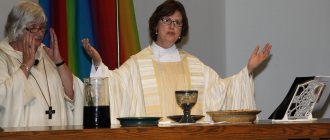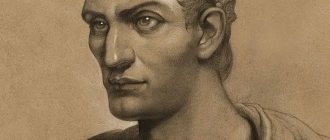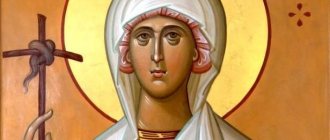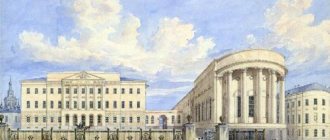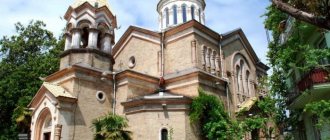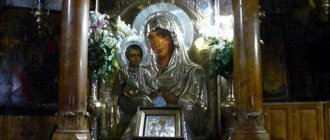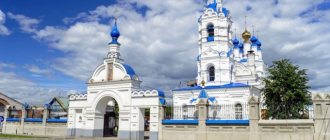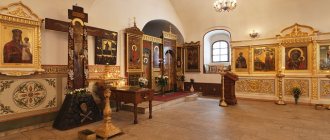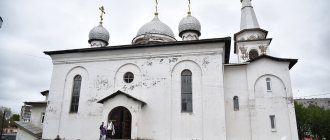Georgia is the Transcaucasian country closest to Russia, with which it is connected not only by faith, and the baptism of Georgia occurred 664 years before the baptism of Rus', but by history and culture. Many glorious names of Orthodox saints, kings, great generals, poets, writers, musicians and actors connect the two great countries. But the most important thing is the spiritual kinship of the peoples living in our countries.
Lot of the Blessed Virgin Mary
Christianity in Georgia originated during the time of the first apostles. Iberia went to the Mother of God by lot, when the first apostles chose countries to preach Christ. But by the will of God this mission was entrusted to the Apostle Andrew.
According to legend, the apostles Matthew, Thaddeus, and Simon Cannait, who suffered martyrdom there, also carried out preaching activities there. The emergence of Christianity was not easy. At the very beginning of its development, it was subjected to persecution for almost three hundred years. King Farsman 1st in the first century carried out brutal persecution of Christians citing hard labor in Tauris.
The history of the formation of Orthodoxy in Georgia deserves special attention, because all the events associated with the baptism of Georgians have specific historical dates, and individual facts of miracles associated with this phenomenon are taken not from legends and traditions, but from actual events witnessed by eyewitnesses .
Orthodoxy received official recognition in Georgia in 324. This great event is associated with the names:
- Saint Nino of Cappadocia. Her preaching contributed to the adoption of baptism by Georgians.
- King Mirian, who turned to faith thanks to Saint Nina and miraculous healing from the blindness that struck him when he turned to the Lord.
- Holy Queen Nana.
It is impossible to imagine Orthodox Georgia without these names.
Saint Nino was born in Cappadocia into a Christian family and received an appropriate upbringing from childhood. Even in her youth, fleeing the persecution of Emperor Diocletian in 303, she, among 37 Christian girls, fled to Armenia, where she miraculously escaped death, and then to Iberia, where she preached Christ.
Baptism
The ruling Georgian king Marian and his wife Nano were staunch pagans. Thanks to Nino’s prayers, the queen, who had been seriously ill for a long time, was healed and received baptism from the saint, which aroused the wrath of the king, who was ready to execute both women. But on July 20, 323, a story similar to what happened to the Apostle Paul happened to him.
While on a hunt and learning that his wife, Queen Nano, had been baptized, he angrily vowed to execute her and Nino. But as soon as he began to threaten Nino and the queen with execution and blaspheme, he immediately became blind. He received no help from his idols and in despair turned to Christ in prayer. His vision returned.
These events took place in the spring of 323, and on May 6 of the same year, healed from sudden blindness and believing in the power of Christ, the Georgian king Mirian converted to Orthodoxy. This event became a turning point in the history of Georgia, since after his conversion the king became a staunch promoter of Orthodoxy in his country.
On October 14, 324 (according to some sources in 326) in Mtskheta on the Kura River, Bishop John, specially sent for this purpose by Tsar Constantine the Great, baptized the people. Tens of thousands of Georgians were baptized that day. This date is the time of the beginning of the baptism of Georgia. Since that time, Orthodoxy has become the official state religion.
To commemorate the victory of Christianity, crosses were erected in the Kartli mountains. And in Mtskheta, King Mirian, who laid the foundation for the construction of churches, built the first Orthodox church in the temple history of the country, Svetitskhoveli (life-giving pillar), that is, the Cathedral of the Twelve Apostles. If you happen to visit Georgia, be sure to visit this temple.
After baptism, Orthodox Georgia never returned to paganism. Crowned apostates who tried to persecute believers in Christ appeared periodically. But the Georgian people never abandoned their faith.
Moreover, there are many known facts of the massive feat of Georgians in the name of the faith of Christ. A well-known historical fact is that in 1227, Muslims led by Shahinshah Jalal Ed Din took Tbilisi and the townspeople were promised the preservation of their lives in exchange for the desecration of the icons placed on the bridge over the Kura River. 100,000 townspeople, including women, old people and children, simple monks and metropolitans chose death in the name of Christ. There are many such examples in the history of Georgia.
Throughout the history of Orthodoxy in Iveria, it had to withstand repeated attempts not only to forcefully destroy it, but also to pervert the purity of its teaching:
- Archbishop Mobidag (434), tried to introduce the heresy of Arianism. However, he was exposed, deprived of power and excommunicated from the Church.
- There were attempts to introduce the heresies of Peter Fullon.
- Albanians (in 650) with their heresy of Manichaeism.
- Monophysites and others.
However, all these attempts were failed, thanks to the Council of Shepherds who harshly condemned heresies, the people who did not accept such attempts, Catholicos Kirion, who forbade believers from any communication with heretics, and the metropolitans who stood firm in the faith and enlightened the believers.
Georgians, who have managed to defend the purity and piety of their faith for many centuries, have earned the respect of even foreign believers. So the Greek monk Procopius wrote: “The Iverians are the best of Christians, the strictest guardians of the laws and regulations of Orthodoxy.”
Today, 85% of Georgians consider themselves Orthodox; the Constitution of the state notes the large role of the Church in its history. This was confirmed once again in his speech by Prime Minister Irakli Kobakhidze, who wrote: “The Church has always fought for the freedom of Georgia.”
Section II. Orthodoxy in Transcaucasia
After reunification with Russia, the Georgian Orthodox Church became part of the Russian Church on the basis of the Exarchate. The West Georgian Catholicos-Patriarch Maxim II (1776 - 1795) retired to Kyiv back in 1795, where he died in the same year. From that moment on, spiritual power over both Catholicosates passed to the East Georgian Catholicos-Patriarch Anthony II (1788 - 1810). In 1810, by decision of the Holy Synod of the Russian Church, he was removed, and in his place the Exarch of Iveria, Metropolitan Varlaam (Eristavi) (1811 - 1817), was appointed. Thus, the Georgian Church became directly dependent on the Russian Orthodox Church and was illegally deprived of its autocephaly.
On the other hand, the presence of Orthodox Georgians under the wing of the Russian Church revived and stabilized spiritual life in Georgia, which could not have been achieved under the previous conditions of constant conquest.
During the existence of the Georgian Exarchate, important positive changes took place: in 1817 a theological seminary was opened in Tiflis, in 1894 - a seminary in Kutaisi. Diocesan women's schools and parochial schools were opened.
Since the 1860s The magazine “Georgian Spiritual Messenger” (in Georgian) began to be published. Since 1886, a bi-weekly church and religious magazine “Mtskemsi” (“Shepherd”) began to be published in Georgian and Russian languages, published until 1902. From 1891 to 1906 and from 1909 to 1917. The weekly official journal “Spiritual Bulletin of the Georgian Exarchate” began to be published in Russian and Georgian with mandatory subscription for the clergy.
Under Exarch Archbishop Paul (Lebedev) (1882 – 1887), the “Brotherhood of the Most Holy Theotokos” was established, which published spiritual and moral literature in Russian and Georgian, organized religious and moral readings, spiritual concerts, etc. In 1897 it was reorganized into the “Missionary Spiritual and Educational Brotherhood.”
Since the 70s of the XIX century. In Abkhazia, the construction of small stone and wooden churches and monasteries is developing. At the same time, it was here, thanks to Russian monks who arrived here from Holy Mount Athos, that the center of Orthodox monasticism was being revived. The fact is that, according to church tradition, the Apostle Simon the Canaanite was buried on this land; also, back in the Middle Ages, Abkhazia was one of the famous centers of Orthodoxy in Western Georgia.
Having received a significant plot of land here (1327 acres), the Russian monks of the St. Panteleimon Athos Monastery from 1875 - 1876. They began to build up this area, as a result of which a monastery was founded. By 1896 the monastery complex was completely built, and by 1900 the New Athos Cathedral was erected. The painting of the monastery and cathedral was carried out by Volga icon painters, the Olovyannikov brothers, and a group of Moscow artists under the leadership of N.V. Malov and A.V. Serebryakov. The new monastery was named New Athos Simono-Kananitsky (New Athos), which still exists today.
A special area of activity of the Georgian exarchs is missionary work among the mountaineers. The preaching of Christianity among the Chechens, Dagestanis and other Caucasian peoples began in the 18th century. In 1724 St. John of Manglis spread Orthodoxy in Dagestan, founding the Holy Cross Monastery in Kizlyar. On his initiative, a special mission was created, headed by Archimandrite Pachomius, during which many Ossetians, Ingush and other highlanders were converted to Holy Orthodoxy.
In 1771, a permanent Ossetian spiritual commission was created (with its center in Mozdok). In the 90s XVIII century its activities temporarily ceased and were resumed in 1815 under the first exarch Varlaam. On the basis of the Ossetian Spiritual Commission in 1860, the “Society for the Restoration of Christianity in the Caucasus” arose, the main tasks of which were, firstly, the preaching of Orthodoxy, and, secondly, the spiritual enlightenment of the Caucasian population.
By the beginning of the twentieth century. In the Georgian Exarchate there were 4 dioceses, 1.2 million Orthodox believers, over 2 thousand churches, approx. 30 monasteries.
With the beginning of the revolutionary events of 1917 and the acute political crisis of the Russian state, a movement for political and church independence began in Georgia.
The entry of the Georgian Church into the Russian Church in 1810 was envisaged on the basis of church autonomy, but soon nothing remained of the autonomous rights of the Georgian Exaracht. Since 1811, bishops of Russian nationality were appointed exarchs in Georgia; Georgian church property was transferred to the full disposal of the Russian authorities, etc. Georgians protested against this situation. The autocephalist sentiments of Orthodox Georgians especially intensified at the end of the 19th and beginning of the 20th centuries. during the work of the Pre-Conciliar Presence (1906 - 1907), convened for the purpose of preparing and studying the project of upcoming reforms in the Russian Orthodox Church.
On March 12, 1917, shortly after the overthrow of the emperor in Russia, Orthodox Georgians independently decided to restore the autocephaly of their Church. Georgian church hierarchs informed the Exarch of Georgia, Archbishop Platon (Rozhdestvensky) (1915 - 1917) that from now on he would cease to be an Exarch.
The church administration of Georgia transferred its decision to the Provisional Government in Petrograd, which recognized the restoration of autocephaly of the Georgian Orthodox Church, but only as a national Church - without geographical boundaries - thus leaving Russian parishes in Georgia under the jurisdiction of the Russian Orthodox Church.
Dissatisfied with this decision, the Georgians filed a protest to the Provisional Government, saying that the recognition of the Georgian Church as a national rather than territorial autocephaly was decisively contrary to church canons. The autocephaly of the Georgian Church must be recognized on a territorial basis within the boundaries of the ancient Georgian Catholicosate.
In September 1917, Catholicos-Patriarch of All Georgia Kirion (Sadzaglishvili) (1917 – 1918) was elected in Georgia, after which the Georgians began to nationalize religious and educational institutions.
The hierarchy of the Russian Orthodox Church, led by Patriarch Tikhon, opposed the act of the Georgian hierarchs, declaring its non-canonical nature.
The Georgians, represented by the new Catholicos-Patriarch Leonid (Okropiridze) (1918 - 1921), stated that Georgia, having united with Russia more than 100 years ago under a single political power, never showed a desire to unite with it in church terms. The abolition of autocephaly of the Georgian Church was a violent act of the secular authorities, contrary to church canons. Catholicos Leonid and the Georgian clergy were completely confident in their correctness and the immutability of observing church rules.
As a result, in 1918 there was a break in prayer communication between the Georgian and Russian Churches, which lasted 25 years. Only the election of Patriarch Sergius of Moscow and All Rus' served as a good pretext for Catholicos-Patriarch of All Georgia Kallistratus (Tsintsadze) (1932 - 1952) to restore relations with the Russian Orthodox Church on the issue of autocephaly.
On October 31, 1943, the reconciliation of the two Churches took place. The Divine Liturgy was celebrated in the ancient cathedral of Tbilisi, uniting Catholicos Kallistratos and the representative of the Moscow Patriarchate, Archbishop Anthony of Stavropol, in prayerful communion. After this, the Holy Synod of the Russian Church, chaired by Patriarch Sergius, issued a determination according to which, firstly, prayerful and Eucharistic communion between the Russian and Georgian Orthodox Churches was recognized as restored, and, secondly, it was decided to ask the Catholicos of Georgia to provide Russian parishes in the Georgian SSR preserve in their liturgical practice those orders and customs that they inherited from the Russian Church.
